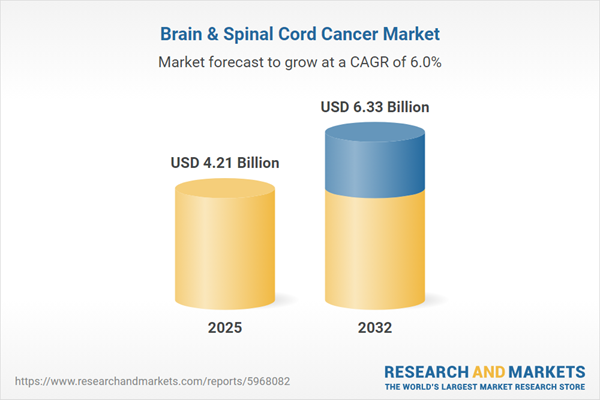Speak directly to the analyst to clarify any post sales queries you may have.
The brain and spinal cord cancer market is undergoing accelerated transformation as organizations adopt digital tools, data-centric models, and integrated workflows to navigate the complex neuro-oncology environment. Senior decision-makers are using informed market intelligence to drive operational advancement, foster innovation, and maintain adaptive strategies.
Market Snapshot: Brain and Spinal Cord Cancer Market Trends
In 2024, the global brain and spinal cord cancer market reached USD 3.98 billion, demonstrating a compound annual growth rate of 5.97%. This upward momentum is reinforced by increased investment in personalized medicine, greater regulatory sophistication, and robust digital infrastructure. Organizations are transitioning to advanced technological platforms, enabling more resilient care delivery and streamlined operations. The market’s evolution is further shaped by the integration of data-driven approaches, optimizing clinical and business strategies to keep pace with rising expectations for targeted treatment and system responsiveness.
Scope & Segmentation
- Cancer Types: The neuro-oncology field includes astrocytoma, ependymoma, glioblastoma, medulloblastoma, meningioma, oligodendroglioma, and schwannoma. Each type requires specialized diagnostics and management, prompting provider teams to focus on tailored care pathways and targeted technology adoption.
- Treatment Types: This market deploys chemotherapy, immunotherapy—including CAR T cell and checkpoint inhibitor options—precision radiation, surgical interventions like craniotomy and laser ablation, and customized targeted care strategies. Collectively, these approaches support greater personalization and operational gains.
- Patient Age Groups: Solutions are developed for adults, geriatrics, and pediatrics, ensuring therapies and services align with clinical and operational needs of each age cohort within treatment environments.
- End Users: Key stakeholders comprise ambulatory surgical centers, cancer clinics, hospitals, and home care providers, all of which establish unique coordination models and benchmark care quality standards affecting industry-wide performance metrics.
- Distribution Channels: The value chain incorporates clinics, hospitals, online and retail pharmacies, as well as specialist outlets, all shaping access to therapies, adherence protocols, and operational productivity suitable to varying healthcare landscapes worldwide.
- Geographic Coverage: The brain and spinal cord cancer market spans the Americas, Europe, Middle East & Africa, and Asia-Pacific regions, each facing distinct regulatory frameworks, infrastructural realities, and clinical demands—necessitating adaptive compliance and informed entry strategies.
- Leading Companies Profiled: Companies at the forefront include Novartis AG, F. Hoffmann-La Roche Ltd, Pfizer Inc., Merck & Co., Inc., Bristol-Myers Squibb Company, AstraZeneca PLC, AbbVie Inc., Bayer AG, Novocure Limited, and Eisai Co., Ltd., all contributing to innovation and competition in the neuro-oncology landscape.
Key Takeaways for Senior Decision-Makers
- Advanced imaging and molecular diagnostic platforms support enhanced patient stratification, leading to more informed therapy selection and improved clinical outcomes in neuro-oncology care.
- Adoption of digital health solutions, combined with novel immunotherapy options, is facilitating inter-disciplinary collaboration and fostering adaptive approaches to complex case management.
- Strategically segmenting care protocols by tumor type, patient age group, or intervention approach enables targeted process refinements and drives specialized operational improvements across organizations.
- Harmonizing operational and compliance processes is critical for consistent quality and risk mitigation, ensuring activities align with local and regional regulatory standards.
- Supply chain continuity is enhanced through advanced inventory oversight and resilient logistics, reducing vulnerability to disruptions and sustaining uninterrupted therapy access for patients.
- Responsive strategies to shifting reimbursement models ensure long-term access to therapies and help organizations maintain financial stability amidst evolving payer landscapes.
Tariff Impact: Navigating Trade Policy and Supply Resilience
Changes in tariff structures, particularly in major healthcare markets, are adding complexity to neuro-oncology supply chains. Executives are responding by refining inventory management, building strategic local and regional partnerships, and adjusting workflow protocols to secure therapy availability. Ongoing regulatory vigilance and organizational agility are now vital for effective contingency planning in the face of persistent external trade disruptions.
Methodology & Data Sources
This report is grounded in a triangulated approach—drawing on peer-reviewed literature, regulatory disclosures, industry references, and interviews with leading clinicians. The structured methodology ensures that findings are validated and practical for executive-level decisions within the neuro-oncology sector.
Why This Report Matters
- Consolidates clinical, operational, and compliance intelligence to support strategic planning and improve resource allocation for stakeholders managing brain and spinal cord cancer portfolios.
- Provides actionable insights into the advantages of digital transformation and advances in distribution, facilitating adaptable and high-value care delivery as operational challenges shift.
- Offers a thorough analysis of regulatory and reimbursement developments, reinforcing scenarios for planning and preparing organizations for forthcoming compliance or operational transitions.
Conclusion
This report enables senior leaders to anticipate and respond to changes in the neuro-oncology market, identify areas for growth, and sustain momentum in both operational and clinical domains as the healthcare environment evolves.
Additional Product Information:
- Purchase of this report includes 1 year online access with quarterly updates.
- This report can be updated on request. Please contact our Customer Experience team using the Ask a Question widget on our website.
Table of Contents
3. Executive Summary
4. Market Overview
7. Cumulative Impact of Artificial Intelligence 2025
Companies Mentioned
The companies profiled in this Brain & Spinal Cord Cancer market report include:- Novartis AG
- F. Hoffmann-La Roche Ltd
- Pfizer Inc.
- Merck & Co., Inc.
- Bristol-Myers Squibb Company
- AstraZeneca PLC
- AbbVie Inc.
- Bayer AG
- Novocure Limited
- Eisai Co., Ltd.
Table Information
| Report Attribute | Details |
|---|---|
| No. of Pages | 181 |
| Published | October 2025 |
| Forecast Period | 2025 - 2032 |
| Estimated Market Value ( USD | $ 4.21 Billion |
| Forecasted Market Value ( USD | $ 6.33 Billion |
| Compound Annual Growth Rate | 5.9% |
| Regions Covered | Global |
| No. of Companies Mentioned | 11 |









